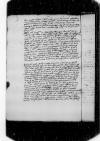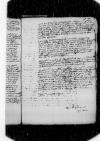Cum obiter ⌊reginali maiestati⌋ in negotiis suis scriberem ad idque parvum mihi temporis spatium esset relictum, superfuit etiam tandem, ut has tumultuarias manu adhuc malagmatis ligata exararem, ne mandatum Maiestatis Vestrae Serenissimae excessisse argui possem, quae sibi per omnem occasionem et de rebus omnibus scribi iussit, facturus sum itaque compendium iterum de iis, quae iustum volumen exigerent.
Post ⌊⌋, quas ⌊hinc⌋ dedi 1527-05-06⌊6 huius1527-05-06⌋, ⌊caesar⌋ venatum 12 ab hinc leugis prope ⌊Turrim Crematam⌋ oppidulum concessit, ut illic partum ⌊imperatricis⌋ — sicut ferebatur — exspectaret. Inde tandem multis precibus et queribundis nuntiis revocatus rursus huc rediit et quo iam partui propinquam ⌊coniugem⌋ consolaretur, crebra iussit fieri iis diebus hastiludia, nullis consiliis et negotiis intentus, quod me satis male habet, ut ex meis ad ⌊reginalem maiestatem⌋ intelliget.
Exspectatur partus ⌊imperatricis⌋ in dies ad praesensque, cum haec scribo, venit rumor et clamor campanarum simul atque hominum, qui imperatrici partu iam laboranti bene precantur, curruntque praecones, qui omnibus bene precari iubent. Spero, quod, antequam istas claudam, me scripturum, quid pepererit aut saltem, quid ex hoc concursu et primis forsan doloribus successit. Mens mea male de illa praesagit; faxit Deus, ut sospes enixa vivat quam diutissime.
Hic omnia dependent ab eventu rerum Italicarum. Istae indutiae per ⌊viceregem⌋ et ⌊pontificem⌋ factae apud omnes hic et apud ⌊caesarem⌋ male audiunt. Dicitur, sed incerto rumore, ⌊Borbonium⌋ nequaquam illas observaturum et quod igitur ⌊pontifex⌋ ⌊viceregem⌋ captum ⌊Florentiam⌋ miserit, ad quam Borbonius citato gradu ferri fertur. Dictum etiam est auctore non satis firmo, ⌊Borbonium⌋ cum 30 milibus militum iam cepisse ⌊Florentiam⌋, item ⌊pontificem⌋ esse mortuum et ⌊regem Christianissimum⌋ etiam nuper ex vivis cessisse; sic hic omnia dubiis rumoribus plena sunt. Timendum est, ne cum alicuius magno malo illi resurgant a mortuis; compertum est prius aliquoties, quod talia praesagia magna mala sunt subsecuta.
 BCz, 242, p. 16
Hic nihil curatur de ⌊Turcis⌋, quasi iam omnes esse<n>t deleti, ne verbum quidem magis auditur, minanturque multa contra ⌊palatinum Transsilvaniae⌋, regem ⌊Hungariae⌋ coronatum, dicuntque ms. ducuntque(!)
⌈dicuntquedicuntque ms. ducuntque(!)
⌉, quod servus non debeat insurgere contra dominum suum, adeoque plane in hoc loquuntur, perinde atque illum in pugno iam continerent.
BCz, 242, p. 16
Hic nihil curatur de ⌊Turcis⌋, quasi iam omnes esse<n>t deleti, ne verbum quidem magis auditur, minanturque multa contra ⌊palatinum Transsilvaniae⌋, regem ⌊Hungariae⌋ coronatum, dicuntque ms. ducuntque(!)
⌈dicuntquedicuntque ms. ducuntque(!)
⌉, quod servus non debeat insurgere contra dominum suum, adeoque plane in hoc loquuntur, perinde atque illum in pugno iam continerent.
Maiestatis Vestrae Serenissimae in componendis illis opera laudatur; sunt tamen plerique, qui alteri parti Maiestatem Vestram plus affectam suspicantur, cum quibus nuper non parvam habui disputationem declarando eis, quod ea, quae Maiestas Vestra Serenissima super ista compositione faceret, non aliorsum, quam ex Christiano et vere pio affectu procederent et ad hoc solum tenderent, cum iis periculis, quae hinc oriri possent, esset proximior aliis, qui forsan non tam longe, ut Maiestas Vestra Serenissima, prospicerent, parumque referre, quod Maiestas Vestra Serenissima ⌊alterius⌋ ⌊sororem⌋ pro regina habuisset, quae iam a multis annis esset mortua, plus habere momenti, quod serenissimus ⌊Bohemiae rex⌋ ⌊neptem⌋ ex ⌊fratre⌋ Maiestatis Vestrae Serenissimae vivam haberet ms. haberem(!)
⌈haberethaberet ms. haberem(!)
⌉ coniugem. Hoc argumento multis visum est a me satisfieri. Hic de iis rebus, quid hactenus inter istos ⌊duos reges⌋ actum sit, nihil certi habemus, summopere scire cupio exitum.
Non solum inter homines male convenit, verum etiam iis temporibus inter elementa caeli non leve discrimen est. Hoc vernum tempus, quod alias solet esse amoenissimum hic et aestu fervens, adeo ventis et tempestatibus crebrum est, quod naturalem suum d cursum deserens in brumam se convertit, per totam ⌊Hispaniam⌋ fructus et vina frigore pro maiore parte exussit. Sunt hinc ante tres menses quidam aulici ⌊caesaris⌋ et nuntius ⌊regis Daciae⌋ extorris, ut mari ⌊Belgas⌋ traicerent, profecti, a quibus hac hora litteras accepi, quod prae continuis tempestatibus et imbribus non audent solvere et aliqui temptantes ⌊Aeolum⌋ ter sunt ex alto aegre in portum relati. Sunt hic adhuc ⌊Hans de Sikinghe(n)⌋ cum ⌊fratre⌋, qui fuit unus capitaneorum equitum, qui ⌊Gdanum⌋ patriam meam obsederant cum ⌊Hartmanno de Cronenberg⌋ ber(?), cui etiam omnia castra et bona per ⌊palatinum Rheni⌋, ⌊lantgrabium Hassiae⌋ et ⌊episcopum Treverensem⌋ fuerunt superioribus annis adempta, qui iuncti certam pecuniariam summam, quam ⌊caesar⌋ ipse ⌊Francisco de Sikingh(en)⌋ debet et ab eo in mutuum per paratas pecunias in ⌊Germania⌋ accepit illique inscriptionem suam desuper dedit, numero 20 milium florenorum Rhenensium, exigunt. Item aliam summam, quae excedit 30 milia flor(enorum),
 BCz, 242, p. 17
quos pro servitiis equitibus ⌊caesar⌋ debuit, cum quibus ante quattuor annos ibant contra ⌊Gallos⌋ et ⌊Franciscus de Siking(hen)⌋ equites istos, quorum ipse dux fuerat, contentos reddiderat. Sed hucusque aliud responsum obtinere non potuerunt, quam quod ⌊Franciscus⌋ fuerat in banno imperiali, cum bellum gessit cum ⌊principibus⌋ praedictis, igitur istiusmodi summae non debent persolvi, illi tamen adhuc laborant, sed timeo, quod frustra in aere piscantur.
BCz, 242, p. 17
quos pro servitiis equitibus ⌊caesar⌋ debuit, cum quibus ante quattuor annos ibant contra ⌊Gallos⌋ et ⌊Franciscus de Siking(hen)⌋ equites istos, quorum ipse dux fuerat, contentos reddiderat. Sed hucusque aliud responsum obtinere non potuerunt, quam quod ⌊Franciscus⌋ fuerat in banno imperiali, cum bellum gessit cum ⌊principibus⌋ praedictis, igitur istiusmodi summae non debent persolvi, illi tamen adhuc laborant, sed timeo, quod frustra in aere piscantur.
Hucusque litteras ad ⌊iudicium camerae imperialis⌋ pro ⌊Gdanensibus⌋ et ⌊Elbingensibus⌋, licet mihi dudum sint promissae, habere non potui, pollicitus mihi tamen est dominus ⌊praepositus et vicecancellarius imperii⌋ heri, quod illas triplicatas post futurum diem Veneris habere debeam istius tenoris, quod mihi satisfaciant. Has cum habuero cum actis hic nuperque(?) inter ⌊caesarem⌋ et ⌊pontificem⌋ transmittam per ⌊Brabantiam⌋ mari. Istam postam pauca papyro onerare possem cogor, alias acta haec cum praesentibus misissem.
Non possum, ut velim, esse longior, iam enim istae a me ex superinscribed⌈exex superinscribed⌉petuntur; nescio, si tempus partus ⌊imperatricis⌋ possint exspectare, in quo adhuc fertur laborare, pulsanturque campanae ad unam partem, ut Deus pro illa rogetur.
Quod reliquum est, humillime supplico Maiestati Vestrae Serenissimae, cum iam fere negotium Barense transactum est castellanusque ⌊arcis Barensis⌋ is habebitur, in quem prius ⌊reginalis maiestas⌋ consensit, dignetur me tandem post tertium annum in quarto saltem clementer revocare litterasque mihi, de quibus 1526-10-14⌊14 Octobris1526-10-14⌋ ⌊⌋, quo tutius redire possem, mittere reditusque mei ac diuturnae duraeque meae servitutis benignam habere rationem.
Deus Optimus Maximus pro communi ⌊Orbis Christiani⌋ salute quam diutissime salvam, incolumem et felicem Maiestatem Vestram Serenissimam conservet. Cui me suppliciter ut domino meo clementissimo commendo.
 BCz, 242, p. 16
Hic nihil curatur de
BCz, 242, p. 16
Hic nihil curatur de  BCz, 242, p. 17
quos pro servitiis equitibus
BCz, 242, p. 17
quos pro servitiis equitibus 

